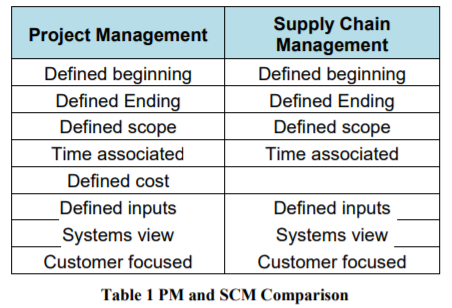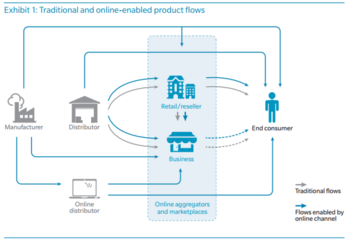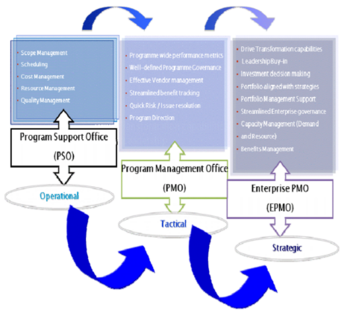Omnichannel strategy
Contents |
Abstract
Managing a supply chain requires collaboration and alignment between a lot of stakeholders with the always present push of the customers. This alone justifies the need for effective project management. It has always been fundamental to the success of supply chain management but it becomes even more crucial now that the supply chain is under their biggest revolution. Modern technologies and strategies aim to tackle the challenges together adding complexity to the supply chain and management of it, but also need to be well implemented, managed and coordinated. Project management develops to adapt and solve the gaps of it. This article reviews the importance of project management in Supply Chain and specifically in a strategy called omnichannel distribution. It provides tools for the project management in this field and reflects about the two tied areas.
Introduction
METER INTRO Retailers have traditionally oriented their strategy to deliver the right product at the right location and time. With the rise of internet and smart devices, and the new capabilities of connection and tracking through multiple digital platforms, new challenges appear to last mile logistics, marketing and multi device purchasing. An opportunity arises for retailers to become truly customer-centered and personalize their shopping experiences. However, it adds new challenges and complexities to the supply chain management.
Specifically, omnichannel refers to the use of both physical and digital channels combined with the delivery of a seamless shopping experience. This strategy requires a complex robust system and management in which the supply chain must adapt quickly to demand, escalate as required and have a fast response in the last mile delivery. [1]
This revolution will mean a transformation in the way that retailers manage their supply chain. According to recent research by MIT, nowadays managers leading complex projects often need to combine traditional and agile methods to give their operations more flexibility and therefore achieve better results.[2]
Project management in the supply chain
There are direct similarities between project management and Supply Chain Management, summarised in the table. .[3] 
Both dimensions are based on the coordination and integration of functionalities and data in an only system. Project management focuses on several key perspectives that the delivery should include: time through deadlines and expectations, quality, at the right and budgeted cost with the correct definition of the scope. None of them are irrelevant to Supply Chain Management. It however includes additional dimensions like distribution, and the place where the product is available and channels that allow it. [4].
Running a supply chain means leading with a crucial characteristic of project management: the risk. Common project risks like the increase in a product life cycle cost, an unacceptable quality or the delay to launch to market may be a direct consequence of a poor project management implementation. When considering the supply chain, delays have a detrimental impact in the whole: competitors can set themselves ahead and costs exponentially increase. In many cases they are a consequence of poor coordination, for example with the supplier leading to part shortages. They both share essential features, the clear definition of goals (and scope in PM), the description of the plan and execution instructions and good resources (including a system for integration). But above all, the most relevant nowadays in our changing environment is flexibility. According to Morgan Henrie, to assist in enhancing the project manager’s flexibility capabilities, their world view should be expanded to include SCM. [5]. “From systems theory it is shown that a system can only respond to changing events if they have the requisite variety to do so (Heyhlighten and Jsolyn 2001). Expanding the project manager world view increases the overall project requisite variety.” [6] In supply chain terms, it is about staying flexible when it comes to material supply, orders, customer forecasts and staff resources. It is required a rapid response to any change that may occur in them. Project Management is fundamental to successful supply chain initiatives. It provides managers with the overview of the program to assume the variability and remain flexible to customers and their demand, and the rest of stakeholders in the system.
How changes will model the supply chain: Omnichannel strategy
A growing number of customers use multiple channels during their shopping journey. These kinds of shoppers are known as omnishoppers, and they expect a seamless experience across channels. Customers prefer retailers who could provide anything, anywhere, at any time and in any way according to customers’ preference [7] For example, an omnishopper might research the characteristics of a product using a mobile app, compare prices on several websites from their laptop, and, finally, buy the product at a physical store or have it delivered to an address. They could also return it in store or having it delivered. This consumer 3.0 uses recent technology to search for information, offer opinions, explain experiences, make purchases, and talk to the brand. In an omnichannel environment, channels are used seamlessly and interchangeably during the search and purchase process, and it is difficult if not virtually impossible for retailers to control this use (Neslin et al., 2014; Verhoef et al., 2015)[8].Regarding technology: In the transformation, the adoption of Integrated channels and big data are a prerequisite for competitiveness (D. Grewal et al, 2017) . Advanced analytics allow to track the stock levels and all the data generated in the supply chain, but are also an input for the pricing strategies across channels, and the comparison to competitors. In terms of supply chain, the main changes required include the need for real-time universal inventory, increase in the speed of the decisions and actions and integrated systems to get one view of orders across the supply chain, check the status of any item and be able to fully control the production process. Big retailers in the world now realise the need for it, and the benefits of the implementation. [9]
In terms of project management, it needs to be assured that the whole organization works with one single common set of shared information and objectives, that improve overall transparency of the supply chain. Departments within the organization should not be an impediment to omnichannel strategies: ecommerce and physical departments shouldn’t compete for customers. This implies that some channels might be rewarded for supporting a sale even if it is not through them where is it closed. (Kusum L.Ailawadi, Paul W.Farris, 2017) [10] .
The highly competitive market is changing the way companies interact. New forms of collaborations are taking place to compete and integrate the technologies in the main business. One example is the partnership of Walmart and Google presented by its CEO, Marc Lore in August 2017. [11]
Omnichannel distribution is in fact the frictionless combination of channels. Consequently, effective and good project management becomes crucial in the implementation of the new strategy, both for the internal to the external management.
APPPM Tools for supply chain and retail
Unfortunately, successful project management is still an issue in the retail sector [12] . However the recent development and innovations set the pace to the enhancement of current methods.
The fast pace and complexity of Supply Chain method involved in Omnichannel strategy might be addressed with some of the following tools form Project Management as suggested by Lisa Anderson [13]
- Use The Critical Path Method (CPM)
- "This well known technique to show in a project schedule the sequence of activities to characterize the most time consuming ones and the relationships between the different tasks could be helpful in this complex and fast paced environment.
- “Using project management tools to identify and manage the critical path is an effective way to do everything from reminding product groups of upcoming collaborative tasks, to making sure that teams and vendors are focusing on the right activity at the right time, or at least aware of delays that can affect other pressing deadlines.”
- Communicate and Collaborate.
- It’s no secret how crucial communication is when managing complexity. Sales and inventory with operations planning processes tie supply chain partners together. It provides a vehicle to communicate and collaborate on demand-and-supply topics. [14]
- Increasing collaboration can be achieved by a project management software. It provides a single source of truth for project and team activity and schedule updates, especially when connection points include global teams working in different time zones." [15]
- When issues arises, it is recommended to bridge with the responsible people, both the owners dependent on the manager and the people he depends upon. A tool necessary for this is RACI Responsibility assignment matrix. It is useful to clarifyi roles and responsibilities in cross-functional/departmental projects and processes, as the organization adapted to the 21st century market is.
- Use Agile Project Management (Agile PM ImperativesAgile PM Wikipedia.)
- Agile, a set of fast and flexible processes that accounts for change, helps teams adapt to marketplace opportunities, and improves business performance, lets you to break down complexity into reasonable chunks. Once you try a simple set of circumstances, you add layers of complexity and test again. Thus, it becomes easier to identify issues and manage complexity because you understand what each layer of complexity affects.
"If you lead a team or a project, the more you learn how to successfully manage complexity, the more you’ll thrive. And simplifying complexity is a starting point that will pay big dividends. Also, in today’s Internet-purchasing world, speed is cornerstone. Since managing complexity improves speed and effectiveness, companies that can manage complexity often leapfrog their competition."
Once reviewed the importance of project management in the industry, the new aspects of it will now have to set the focus on:
- Owning one source of information, accessible to the whole organization. Information and objectives need to be shared and aligned.
- A suggested approach for this is the Enterprise Project Management Office (EPMO) [16] . While the traditional PMOs focus on doing the things right, EPMO includes the right way of doing this. The strategic goals are achieved when the teams are supported by this shared business function.
- Accelerate communication with project members and stakeholders. Since decisions must be made faster, the interaction with stakeholders is ought to be continuous.
- Visibility to have a quick real-time status overview of all retail projects in one place – anywhere at any time.
It becomes more important than ever using a good software that integrates the store data with the online channel, the demand and trends that feeds the marketing decisions, and optimises the operations with the cost and time dimensions.
The improvement of the processes in the new circumstances will often result in partnerships with suppliers and other stakeholders. This another dimension of complication that needs to be considered in the new supply chain management.
Additional reflection and Limitations
As research has explored, project management in retail has an extra dimension: the customer. Project management has traditionally focused on conventional planning tasks although human behaviour is particularly important in the retail setting, where projects are generally focused on testing new concepts, increasing collaboration, and implementing new technologies. [17]
It can be argued however, that with the mentioned revolution, that is bringing the retail market by storm and shaping a complete new way the supply chains, requires new methods and approaches in project management. [18] Several authors claim that it is the time to incorporate better data analytics in the planning stages, mass personalization, networks of teams rather than individual… [19]
In the end, evolution is not applying old tools for new strategies and organizations but reinventing the way things happen adapting accordingly to the new environment. -
References
- ↑ [ http://web.efzg.hr/dok/TRG/ddunkovic/VERHOEF%201.pdf] From Multi-Channel Retailing to Omni-Channel Retailing
- ↑ [ http://sloanreview.mit.edu/article/what-successful-project-managers-do/] What Successful Project Managers Do (2015)
- ↑ [http://www.ipma-usa.org/articles/PM_WorldView.pdf] Project Management: The Supply Chain View (2007)
- ↑ [ http://supplychain-mechanic.com/?p=275] Role of Project Management within procurement and supply chain
- ↑ [http://www.ipma-usa.org/articles/PM_WorldView.pdf] Project Management: The Supply Chain View (2007)
- ↑ [http://www.ipma-usa.org/articles/PM_WorldView.pdf] Heyhlighten, F. and C. Jsolyn (2001). The Law of Requisite Variety. 1993.
- ↑ [ https://www.linkedin.com/pulse/complexities-omni-channel-retailing-importance-oms-jaganmohan] Complexities in omnichannel
- ↑ [https://www.ncbi.nlm.nih.gov/pmc/articles/PMC4963459/] Omnichannel Customer Behaviour: Key Drivers of Technology Acceptance and Use and Their Effects on Purchase Intention (2016)
- ↑ [https://risnews.com/ekn-research-el-corte-ingles-case-study-led-approach-supply-chain-success] Case Study: El Corte Inglés Success - “ECI needed to create a single system able to support the functionality desired to provide home delivery for all customer orders, enable new types of cross- channel services and returns, and extend its network of suppliers, ultimately enabling a superior customer experience”)
- ↑ [https://search.proquest.com/openview/030bac7bf5d09ab943aaf1d5bb59abac/1.pdf?pq-origsite=gscholar&cbl=41988 ] Managing Multi- and Omni-Channel Distribution: Metrics and Research Directions (2017)
- ↑ [http://blog.walmart.com/innovation/20170823/walmart-google-partner-to-make-shopping-even-easier-heres-how ] “Today, we’re announcing an exciting partnership with Google to do just that. Starting in late September, we’ll be working with Google to offer hundreds of thousands of items for voice shopping via Google Assistant – the largest number of items currently offered by a retailer through the platform.”
- ↑ [http://www.tandfonline.com/doi/abs/10.1080/09593960802113950?src=recsys&journalCode=rirr20] Project management in retailing: integrating the behavioral dimension (2017)
- ↑ [https://www.liquidplanner.com/blog/manage-supply-chain-complexity-using-project-management/] Lisa Anderson , August 25 2016, How Project Management Tackles Supply Chain Complexity
- ↑ [https://www.liquidplanner.com/blog/manage-supply-chain-complexity-using-project-management/] How Project Management Tackles Supply Chain Complexity
- ↑ [https://www.liquidplanner.com/blog/manage-supply-chain-complexity-using-project-management/] How Project Management Tackles Supply Chain Complexity
- ↑ [https://www.projectsmart.co.uk/white-papers/the-growing-importance-of-epmo-in-todays-organisations.pdf] The growing importance of EPMO (Enterprise Project Management Office) in today’s organizations
- ↑ [http://www.tandfonline.com/doi/abs/10.1080/09593960802113950?src=recsys&journalCode=rirr20] Project management in retailing: integrating the behavioural dimension (2017)
- ↑ [ https://www.pmi.org/-/media/pmi/documents/public/pdf/learning/thought-leadership/pulse/pulse-of-the-profession-2017.pdf] Success Rates Rise- 9th Global PM Survey (2017)
- ↑ [ https://www.workzone.com/blog/top-10-project-management-trends-for-2017/] Top 10 Project Management Trends for 2017

